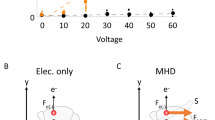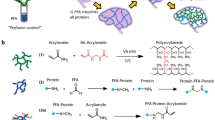Abstract
CLARITY is a method for chemical transformation of intact biological tissues into a hydrogel-tissue hybrid, which becomes amenable to interrogation with light and macromolecular labels while retaining fine structure and native biological molecules. This emerging accessibility of information from large intact samples has created both new opportunities and new challenges. Here we describe protocols spanning multiple dimensions of the CLARITY workflow, ranging from simple, reliable and efficient lipid removal without electrophoretic instrumentation (passive CLARITY) to optimized objectives and integration with light-sheet optics (CLARITY-optimized light-sheet microscopy (COLM)) for accelerating data collection from clarified samples by several orders of magnitude while maintaining or increasing quality and resolution. The entire protocol takes from 7–28 d to complete for an adult mouse brain, including hydrogel embedding, full lipid removal, whole-brain antibody staining (which, if needed, accounts for 7–10 of the days), and whole-brain high-resolution imaging; timing within this window depends on the choice of lipid removal options, on the size of the tissue, and on the number and type of immunostaining rounds performed. This protocol has been successfully applied to the study of adult mouse, adult zebrafish and adult human brains, and it may find many other applications in the structural and molecular analysis of large assembled biological systems.
This is a preview of subscription content, access via your institution
Access options
Subscribe to this journal
Receive 12 print issues and online access
$259.00 per year
only $21.58 per issue
Buy this article
- Purchase on Springer Link
- Instant access to full article PDF
Prices may be subject to local taxes which are calculated during checkout








Similar content being viewed by others
References
Bock, D.D. et al. Network anatomy and in vivo physiology of visual cortical neurons. Nature 471, 177–182 (2011).
Briggman, K.L., Helmstaedter, M. & Denk, W. Wiring specificity in the direction-selectivity circuit of the retina. Nature 471, 183–188 (2011).
Conchello, J.A. & Lichtman, J.W. Optical sectioning microscopy. Nat. Methods 2, 920–931 (2005).
Helmchen, F. & Denk, W. Deep tissue two-photon microscopy. Nat. Methods 2, 932–940 (2005).
Tang, J., Germain, R.N. & Cui, M. Superpenetration optical microscopy by iterative multiphoton adaptive compensation technique. Proc. Natl. Acad. Sci. USA 109, 8434–8439 (2012).
Micheva, K.D., Busse, B., Weiler, N.C., O'Rourke, N. & Smith, S.J. Single-synapse analysis of a diverse synapse population: proteomic imaging methods and markers. Neuron 68, 639–653 (2010).
Ragan, T. et al. Serial two-photon tomography for automated ex vivo mouse brain imaging. Nat. Methods 9, 255–258 (2012).
Dodt, H.U. et al. Ultramicroscopy: three-dimensional visualization of neuronal networks in the whole mouse brain. Nat. Methods 4, 331–336 (2007).
Hama, H. et al. Scale: a chemical approach for fluorescence imaging and reconstruction of transparent mouse brain. Nat. Neuroscience 14, 1481–1488 (2011).
Ke, M.T., Fujimoto, S. & Imai, T. SeeDB: a simple and morphology-preserving optical clearing agent for neuronal circuit reconstruction. Nat. Neuroscience 16, 1154–1161 (2013).
Kim, S.Y., Chung, K. & Deisseroth, K. Light microscopy mapping of connections in the intact brain. Trends Cognit. Sci. 17, 596–599 (2013).
Erturk, A. et al. Three-dimensional imaging of solvent-cleared organs using 3DISCO. Nat. Protocols 7, 1983–1995 (2012).
Chung, K. et al. Structural and molecular interrogation of intact biological systems. Nature 497, 332–337 (2013).
Susaki, E.A. et al. Whole-brain imaging with single-cell resolution using chemical cocktails and computational analysis. Cell 157, 726–739 (2014).
Planchon, T.A. et al. Rapid three-dimensional isotropic imaging of living cells using Bessel beam plane illumination. Nat. Methods 8, 417–423 (2011).
Siedentopf, H. & Zsigmondy, R. Uber Sichtbarmachung und Grössenbestimmung ultramikroskopischer Teilchen, mit besonderer Anwendung auf Goldrubingläser. Ann. Phys. 10, 1–39 (1903).
Huisken, J. & Stainier, D.Y. Selective plane illumination microscopy techniques in developmental biology. Development 136, 1963–1975 (2009).
Huisken, J., Swoger, J., Del Bene, F., Wittbrodt, J. & Stelzer, E.H. Optical sectioning deep inside live embryos by selective plane illumination microscopy. Science 305, 1007–1009 (2004).
Tomer, R., Khairy, K., Amat, F. & Keller, P.J. Quantitative high-speed imaging of entire developing embryos with simultaneous multiview light-sheet microscopy. Nat. Methods 9, 755–763 (2012).
Krzic, U., Gunther, S., Saunders, T.E., Streichan, S.J. & Hufnagel, L. Multiview light-sheet microscope for rapid in toto imaging. Nat. Methods 9, 730–733 (2012).
Santi, P.A. et al. Thin-sheet laser imaging microscopy for optical sectioning of thick tissues. BioTechniques 46, 287–294 (2009).
Hell, S.W. Microscopy and its focal switch. Nat. Methods 6, 24–32 (2009).
Greger, K., Swoger, J. & Stelzer, E.H. Basic building units and properties of a fluorescence single plane illumination microscope. Rev. Sci. Instrum. 78, 023705 (2007).
Keller, P.J., Schmidt, A.D., Wittbrodt, J. & Stelzer, E.H. Reconstruction of zebrafish early embryonic development by scanned light-sheet microscopy. Science 322, 1065–1069 (2008).
Keller, P.J. et al. Fast, high-contrast imaging of animal development with scanned light sheet-based structured-illumination microscopy. Nat. Methods 7, 637–642 (2010).
Kalchmair, S., Jahrling, N., Becker, K. & Dodt, H.U. Image contrast enhancement in confocal ultramicroscopy. Optics Lett. 35, 79–81 (2010).
Hammouda, B. Temperature effect on the nanostructure of SDS micelles in water. J. Res. Natl. Inst. Stand. Technol. 118, 151–167 (2013).
Peng, H., Ruan, Z., Long, F., Simpson, J.H. & Myers, E.W. V3D enables real-time 3D visualization and quantitative analysis of large-scale biological image data sets. Nat. Biotechnol. 28, 348–353 (2010).
Emmenlauer, M. et al. XuvTools: free, fast and reliable stitching of large 3D datasets. J. Microscopy 233, 42–60 (2009).
Yu, Y. & Peng, H. Automated high speed stitching of large 3D microscopic images. Biomedical Imaging: From Nano To Macro, 2011 IEEE International Symposium On March 30-April 2, 2011, Chicago 238–241 (2011).
Bria, A. & Iannello, G. TeraStitcher: a tool for fast automatic 3D-stitching of teravoxel-sized microscopy images. BMC Bioinformatics 13, 316 (2012).
Myatt, D.R., Hadlington, T., Ascoli, G.A. & Nasuto, S.J. Neuromantic: from semi-manual to semi-automatic reconstruction of neuron morphology. Front. Neuroinform. 6, 4 (2012).
Patterson, G.H. & Piston, D.W. Photobleaching in two-photon excitation microscopy. Biophys. J. 78, 2159–2162 (2000).
Hopt, A. & Neher, E. Highly nonlinear photodamage in two-photon fluorescence microscopy. Biophys. J. 80, 2029–2036 (2001).
Koester, H.J., Baur, D., Uhl, R. & Hell, S.W. Ca2+ fluorescence imaging with pico- and femtosecond two-photon excitation: signal and photodamage. Biophys. J. 77, 2226–2236 (1999).
Acknowledgements
We thank the entire Deisseroth laboratory for helpful discussions and Anna Lei for technical assistance. K.D. is supported by the Defense Advance Research Projects Agency (DARPA) Neuro-FAST program, the National Institute of Mental Health (NIMH), the National Science Foundation (NSF), the National Institute on Drug Abuse (NIDA), the Simons Foundation and the Wiegers Family Fund. All CLARITY tools and methods described are distributed and supported freely (http://clarityresourcecenter.org, http://wiki.claritytechniques.org) and discussed in an open forum (http://forum.claritytechniques.org).
Author information
Authors and Affiliations
Contributions
R.T. and K.D. wrote the paper with input from L.Y. on the content. R.T., L.Y. and B.H. prepared the clarified samples, and R.T. developed the imaging framework. K.D. supervised the project.
Corresponding author
Ethics declarations
Competing interests
The authors declare no competing financial interests.
Integrated supplementary information
Supplementary Figure 1 Sample transparency at key stages of the CLARITY protocol.
Pictures of representative brain samples are shown during the key stages of clarification: (a) hydrogel-embedded mouse brain, (b) after lipid removal, (c) after washing of the residual SDS micelle with PBST, and (d) after 2 hours of refractive index homogenization with FocusClear at 37°C with gentle shaking.
Supplementary Figure 2 Summary of the control electronics framework and COLM parts.
FPGA logic is used to control and synchronize various parts of the microscope.
Supplementary information
Supplementary Figure 1
Sample transparency at key stages of the CLARITY protocol. (PDF 513 kb)
Supplementary Figure 2
Summary of the control electronics framework and COLM parts. (PDF 422 kb)
Volume rendering of whole mouse brain volume acquired from an intact clarified Thy1-eYFP mouse brain using 10× magnification objective in COLM.
The dataset was down-sampled 4 fold in each lateral pixel dimension to make the volume rendering feasible with current computing power. The entire image volume was acquired in ∼4 hours. (MOV 54043 kb)
Rendering of 3.15 mm × 3.15 mm × 5.3 mm volume acquired from an intact clarified Thy1-eYFP mouse brain using the 25× magnification objective in COLM.
The dataset was down-sampled 2 fold in each lateral pixel dimension. The entire image volume was acquired in ∼1.5 hours. (MOV 39475 kb)
41596_2014_BFnprot2014123_MOESM452_ESM.mov
Rendering of 1.837 mm × 0.959 × 5 mm volume acquired from an intact clarified Thy1-eYFP mouse brain using the 25× magnification objective in a confocal microscope. (MOV 27073 kb)
Rights and permissions
About this article
Cite this article
Tomer, R., Ye, L., Hsueh, B. et al. Advanced CLARITY for rapid and high-resolution imaging of intact tissues. Nat Protoc 9, 1682–1697 (2014). https://doi.org/10.1038/nprot.2014.123
Published:
Issue Date:
DOI: https://doi.org/10.1038/nprot.2014.123
This article is cited by
-
Current and future applications of light-sheet imaging for identifying molecular and developmental processes in autism spectrum disorders
Molecular Psychiatry (2024)
-
CLARITY increases sensitivity and specificity of fluorescence immunostaining in long-term archived human brain tissue
BMC Biology (2023)
-
Comprehensive profiling of stem-like features in pediatric glioma cell cultures and their relation to the subventricular zone
Acta Neuropathologica Communications (2023)
-
TSA-PACT: a method for tissue clearing and immunofluorescence staining on zebrafish brain with improved sensitivity, specificity and stability
Cell & Bioscience (2023)
-
MEK inhibition reduced vascular tumor growth and coagulopathy in a mouse model with hyperactive GNAQ
Nature Communications (2023)
Comments
By submitting a comment you agree to abide by our Terms and Community Guidelines. If you find something abusive or that does not comply with our terms or guidelines please flag it as inappropriate.



